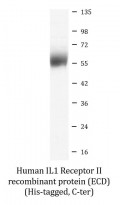ARG70303
Human IL1 Receptor II recombinant protein (ECD) (His-tagged, C-ter)
Human IL1 Receptor II recombinant protein (ECD) (His-tagged, C-ter) for Binding Activity,SDS-PAGE and Human
Overview
| Product Description | HEK293 expressed, His-tagged (C-ter) Human IL1 Receptor II recombinant protein (ECD). |
|---|---|
| Tested Reactivity | Hu |
| Tested Application | Binding, SDS-PAGE |
| Target Name | IL1 Receptor II (ECD) |
| Species | Human |
| A.A. Sequence | Met1 - Glu343 of Human IL1 Receptor II (NP_004624.1) with 6X His tag at the C-terminus. |
| Expression System | HEK293 |
| Alternate Names | IL-1 type II receptor; mIL-1RII; CDw121b; Interleukin-1 receptor type II; CD antigen CD121b; CD121b; Interleukin-1 receptor type 2; IL1R2c; sIL-1R2; IL1RB; Interleukin-1 receptor beta; sIL-1RII; IL-1R-2; IL-1RT2; IL-1RT-2; CD121 antigen-like family member B; mIL-1R2; IL-1R-beta |
Application Instructions
| Application Note | Binding activity test: Measured by its binding ability in a functional ELISA. Immobilized Recombinant Human IL1R2 at 2µg/ml (100µl/well) can bind Human IL1RA with a linear range of 31.25-43.5 ng/ml. |
|---|
Properties
| Form | Powder |
|---|---|
| Purification Note | 0.22 µm filter sterilized. Endotoxin level is <0.1 EU/µg of the protein, as determined by the LAL test. |
| Purity | >95% (by SDS-PAGE) |
| Buffer | PBS (pH 7.4) |
| Reconstitution | Reconstitute to a concentration of 0.1 - 0.5 mg/ml in sterile distilled water. |
| Storage Instruction | For long term, lyophilized protein should be stored at -20°C or -80°C. After reconstitution, aliquot and store at -20°C for up to one month, at 2-8°C for up to one week. Storage in frost free freezers is not recommended. Avoid repeated freeze/thaw cycles. Suggest spin the vial prior to opening. |
| Note | For laboratory research only, not for drug, diagnostic or other use. |
Bioinformation
| Gene Symbol | IL1R2 |
|---|---|
| Gene Full Name | interleukin 1 receptor, type II |
| Background | The protein encoded by this gene is a cytokine receptor that belongs to the interleukin 1 receptor family. This protein binds interleukin alpha (IL1A), interleukin beta (IL1B), and interleukin 1 receptor, type I(IL1R1/IL1RA), and acts as a decoy receptor that inhibits the activity of its ligands. Interleukin 4 (IL4) is reported to antagonize the activity of interleukin 1 by inducing the expression and release of this cytokine. This gene and three other genes form a cytokine receptor gene cluster on chromosome 2q12. Alternative splicing results in multiple transcript variants and protein isoforms. Alternative splicing produces both membrane-bound and soluble proteins. A soluble protein is also produced by proteolytic cleavage. [provided by RefSeq, May 2012] |
| Function | Non-signaling receptor for IL1A, IL1B and IL1RN. Reduces IL1B activities. Serves as a decoy receptor by competetive binding to IL1B and preventing its binding to IL1R1. Also modulates cellular response through non-signaling association with IL1RAP after binding to IL1B. IL1R2 (membrane and secreted forms) preferentially binds IL1B and poorly IL1A and IL1RN. The secreted IL1R2 recruits secreted IL1RAP with high affinity; this complex formation may be the dominant mechanism for neutralization of IL1B by secreted/soluble receptors. [UniProt] |
| Cellular Localization | Isoform Short: Secreted. Isoform Long: Cell membrane; Single-pass type I membrane protein. [UniProt] |
| Calculated MW | 45 kDa |
| PTM | A soluble form (sIL1R2) can also be produced by proteolytic cleavage at the cell surface (shedding) involving a metalloproteinase; hovever, several sIL1R2 forms ranging from 45 and 60 kDa are reported. [UniProt] |
Images (1) Click the Picture to Zoom In






